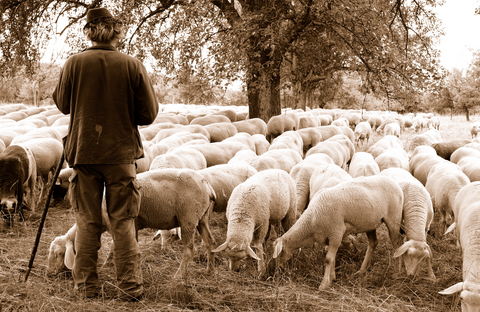
Sheepskin is a natural material that has stood the test of time and is part of many cultures. Used for manufacturing clothing, blankets, rugs and other accessories, it is appreciated for its quality, softness, warmth and comfort. But how did it become the fashion and decorative object it is today? Let's discover how this versatile material has shaped our world through the ages.
Ancient origins
Sheepskin was one of the first materials humans used. During prehistoric times,

humans hunted wild sheep to feed on their meat and clothe themselves in their skins. They also used sheepskin to make blankets and tents. Its insulating properties were a decisive advantage in surviving the harshness of varied climates. Ancient civilizations raised sheep for food and used their skins to make clothes, shoes, bags, gloves, belts, and other everyday objects.
Sheepskin in ancient Greece
Sheepskin played an essential role in ancient Greece, both in terms of clothing and symbolism. As it was rare and expensive, sheepskin was considered a sign of wealth and nobility. It was also sacred in Greek mythology and associated with several deities, including Zeus, Apollo, Athena, and Hermes. It is also at the heart of one of the most famous legends, like the tale of Jason and the Golden Fleece, a magical sheepskin guarded by a dragon.
Medieval Europe and the Renaissance
During the Middle Ages and the European Renaissance, royalty flourished with sheepskin, making it a luxury accessory symbol of refinement. From sumptuous garments to sophisticated accessories, it was prized for its comfort and quality.
It was also used to make parchment, which was the main writing medium in the Middle Ages. Parchment was made from sheepskin, goatskin or calfskin, which was cleaned, scraped, stretched and dried.
In indigenous cultures
Sheepskin has played an essential role in manufacturing traditional clothing and handicrafts. It was also used to make practical and ritual objects, such as blankets, rugs, bags, drums, flutes and rattles. Considered a sacred material, it symbolizes the connection with nature, ancestors and spirits. In the past, sheepskin was offered as a gift, in exchange, or to pay homage. To this day, sheepskin remains an essential element of the cultural identity of First Nations people.
 Sheepskin in the Islamic world
Sheepskin in the Islamic world
Sheepskin has influenced Muslim art, crafts, decoration and architecture. For a long time, it was used to make rugs, cushions, curtains and lampshades, often dyed in bright colours or decorated with floral or geometric motifs. Appreciated for its finesse, suppleness and shine, it was also used to make luxury items, such as caskets, bindings, cases and boxes.
Sheepskin in modern times
The use of sheepskin has evolved with industrialization and has taken an important place in fashion and interior design. It is used to make garments and accessories, including jackets, coats, vests, scarves, caps, slippers, and bags. Various fashion trends, including romantic, bohemian, rock, and vintage styles, have adopted it.
Appreciated for its cozy, warm and comfortable look, sheepskin has also been used to make furniture and decor objects such as armchairs, sofas, cushions, wool throws, and rugs. It can be combined with a variety of styles, including Scandinavian, rustic, modern and luxury living spaces.
Sheepskin today
As popular as ever in contemporary fashion and interior design, sheepskin is

appreciated for its quality, softness and warmth, along with its natural, durable look. Sheepskin is used to create cocooning, Zen or fancy atmospheres. It adds texture, light and contrast to your living environment. It can be combined with all styles, from the most classic to the most original. What’s more, it is available in a variety of colours.
Different types of sheepskin
Sheepskin varieties are as diverse as the breeds and regions of origin. The treatment will influence texture and appearance, offering a range of choices to suit all tastes.
- Icelandic sheepskin is a long, thick, curly wool. It is very warm, soft and plush, ideal for rugs or blankets.
- Australian sheepskin comes from Merino sheep, whose wool is fine, dense and smooth. It is very soft, light and breathable, ideal for garments, shoes, socks* and other accessories.
- New Zealand sheepskin is a medium-fibered, soft and shiny wool. It is comfortable, durable and easy to care for, making it ideal for furniture, cushions or shoes.
- Tibetan sheepskin features long, curly, fluffy wool. It is very luxurious, elegant, and unique. It is perfect for rugs, throws, or armchairs.
Environmental and ethical impacts of sheepskin
The use of sheepskin raises environmental and ethical issues. Indeed, sheepskin production requires water, energy and land resources. Due to these challenges, there are alternatives and sustainable practices. For example, sheepskin from organic farming, which respects environmental and social standards, is the preferred choice. At Garneau, we opt for a sheepskin that comes from the recovery of sheepskins raised for their meat. The animal is, therefore, used in its entirety, considerably reducing the waste.
To this day, the heritage of this noble material endures. Sheepskin remains a sure bet for combining comfort and refinement. Its natural benefits and mainstay status in the world of fashion and interior design ensure that it will continue to grace and warm the homes of many generations to come.
*Merino wool socks are available in men’s and women’s sizes.
https://www.ledevoir.com/economie/545257/la-laine-quebecoise-faufilee-dans-l-oubli-ou-autre-chose-de-meilleur
https://ici.radio-canada.ca/ohdio/premiere/emissions/la-nature-selon-boucar/segments/entrevue/34320/mouton-histoire-laine-viande-bergerie-johanne-cameron
https://www.comptoir-irlandais.com/fr/cms/848/la-laine#:~:text=LES%20ORIGINES%20DE%20LA%20LAINE,20%25%20de%20la%20production%20mondiale.
https://fr.wikipedia.org/wiki/Histoire_de_la_laine_et_du_drap
https://fr.wikipedia.org/wiki/Laine
https://fr.wikipedia.org/wiki/Parchemin
https://www.sciencesetavenir.fr/archeo-paleo/archeologie/parchemins-medievaux-du-mouton-plutot-que-du-veau-pour-s-affranchir-des-fraudeurs_153134
https://www.lefigaro.fr/culture/quand-les-parchemins-en-peau-de-mouton-du-moyen-age-permettaient-de-dejouer-les-faussaires-20210412
